-1000.jpg)
Gold table runner embroidered with flowers from Hill of Tarvit, Fife (detail), Satin embroidered with coloured silk threads, c1900–20. Image © The National Trust for Scotland.
Dovecot Studios, Edinburgh
25 October 2024 – 18 January 2025
by BETH WILLIAMSON
It is not often that you get to see 80 objects from 18 historic houses, and spanning 200 years, all in one place. Yet that is what you have in this extraordinary exhibition as the National Trust for Scotland (NTS) collaborates with Dovecot Studios in Edinburgh to reveal the skill, inspiration and design in NTS’s collection of embroidered textiles. Spanning the period 1720 to 1920, the exhibition includes everything from sumptuous armchairs and magnificent bed hangings to complex designs for fire screens, tablecloths, cushions, and tea cosies. What makes this exhibition special is that these items are displayed alongside detailed drawings and designs, and portraiture, as well as the histories of the makers. This is not a display of objects for their own sake, as all come with a richly woven back story that enriches and enlivens the experience of looking.
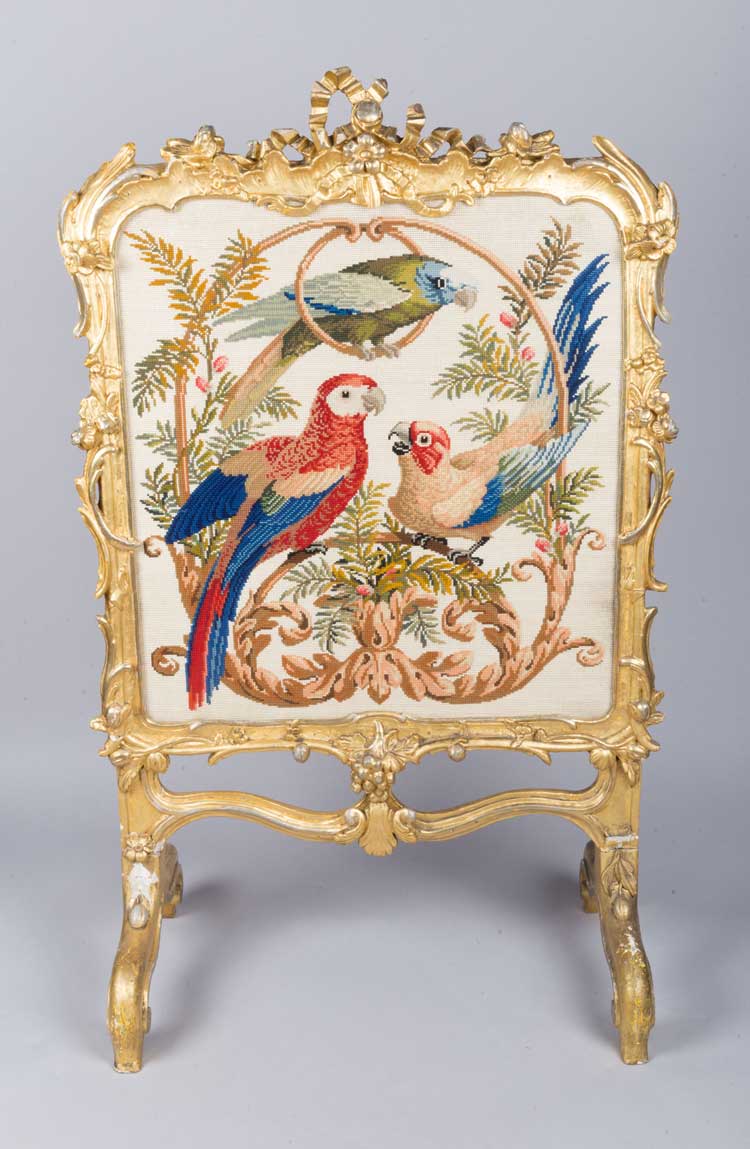
Firescreen embroidered by Lady Augusta Kennedy-Erskine from the House of Dun, 1835–65. © The National Trust for Scotland.
Many of these delicate objects have not been on public display until now. That they can be shared for the first time here is the culmination of a two-year programme of research and conservation. Taking the objects out of the historic houses where they usually reside (including Newhailes House, Drum Castle, House of Dun, Weaver’s Cottage and The Hill House) and placing them, instead, in a gallery setting imbues them with new significance as works of art in their own right. Furthermore, bringing them together in this way lends a fresh perspective on Scotland’s heritage of embroidery and domestic interior design far beyond that of a few well-known names. It also gives voice to those people whose skill and expertise has been hidden for far too long. Bringing these highly skilled and artistic makers out of the shadows and into the public histories of Scottish needlecraft and interiors is an important step in addressing their underrepresentation.
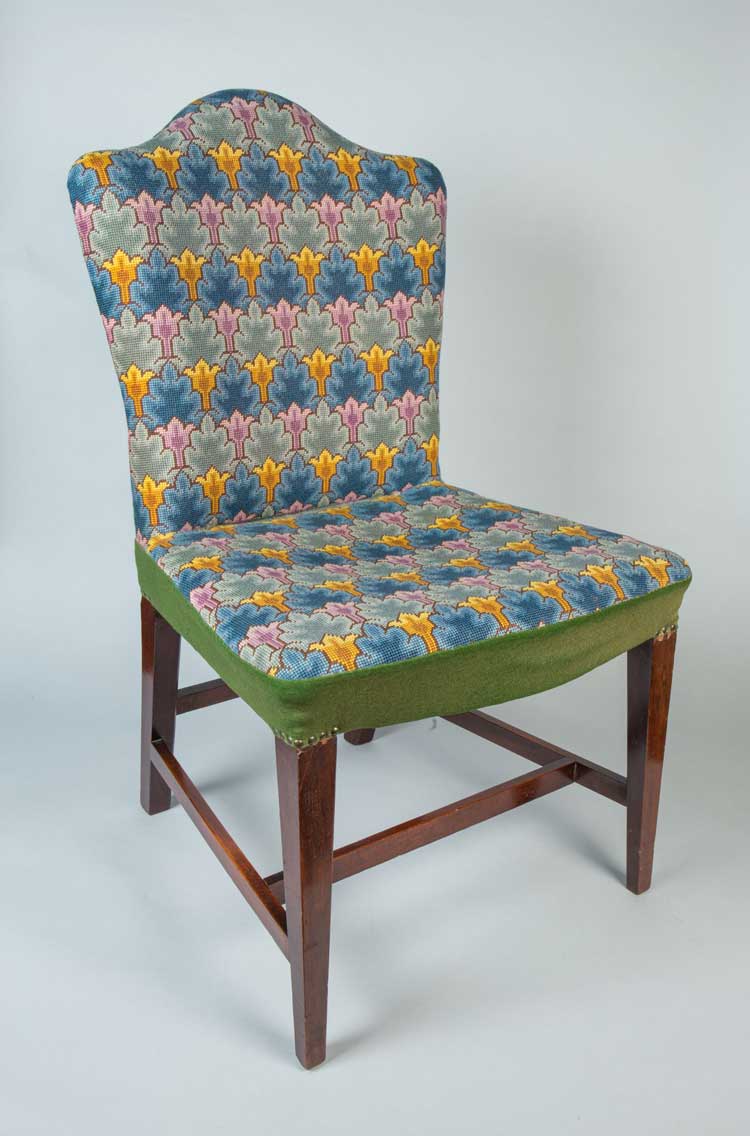
Mahogany chair with tent-stitch and green velvet upholstering from Drum Castle, 1860s. © The National Trust for Scotland.
When George III, a known supporter of the arts, ascended to the throne to become King of Great Britain and Ireland in 1760, he heralded a period of shifting styles in British architecture and interiors that was also reflected in textiles. As global trade expanded through the East India Company, which accounted for about half of world trade in the mid-1700s and early1800s, design ideas expanded and changed too. Later, Glasgow School of Art strengthened the position of embroidery as a serious subject of study when technical studios opened in the 1890s and embroidery was overseen by Jessie Newbery (1864-1948) and quicky gained renown for its designs. By the end of the first world war, life had changed dramatically and textiles did too.
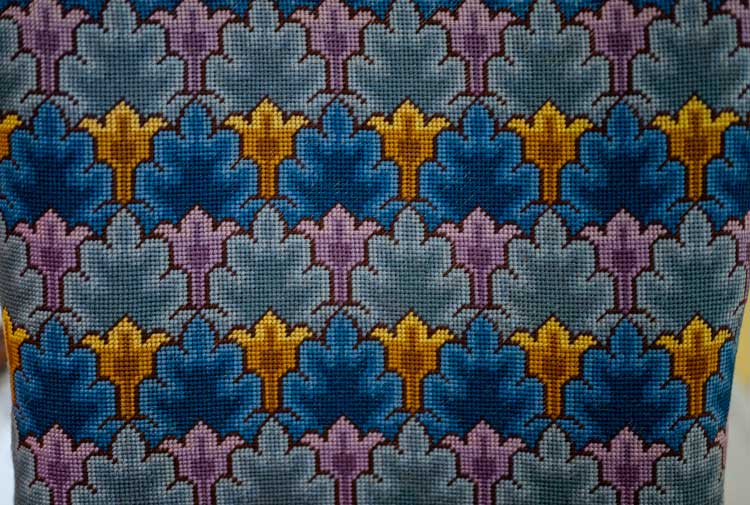
Chair cover sewn by Anna Forbes Irvine, 1869s (detail) from Drum Castle, Aberdeenshire. Image courtesy of Dovecot Studios. Photo: Phil Wilkinson.
The exhibition is organised across four themes that respond to the strengths of the NTS’s collection of embroidered household textiles: inspiration and design; display and decoration; skills for life; and commissions, collaborations and gifts. It opens by addressing the ubiquity of embroidery on Scottish design of the period. It was everywhere in domestic decor and furnishings. Very much a family affair, artists, mostly women, often learned their stitchery from close relatives through copying and the creation of samplers. The first work you come across in the exhibition is an unusual sampler in the form of a map of Scotland. Made in the 1840s by maker Ann Forbes Leslie (later Forbes Irvine), the outline smaller map combines needlework with geography. Exquisite bed valances sewn by Mary Bristow and Elyza Fraser adorn another gallery wall. Sewn over a 10-year period 1797-1805, this collaborative work was made by companions Bristow and Frazer. They met in Bristol in 1781 and the friends travelled extensively in Europe. When Fraser inherited Castle Fraser from her brother in 1792, she and Bristow spent part of each year there, enjoying the gardens and incorporating floral designs into curtains, pelmets and these valances. Their love of horticulture shines through. An outstanding draught screen sewn by Lady Mary Dalyell in the 1910s, and normally resident in House of the Binns in West Lothian, is a beautiful example of work inspired by earlier designers such as William Morris and Selwyn Image. Dalyell was an avid maker who grew up sewing for Queen Mary’s Needlework Guild during the first world war, another fascinating backstory that adds immensely to this exhibition.
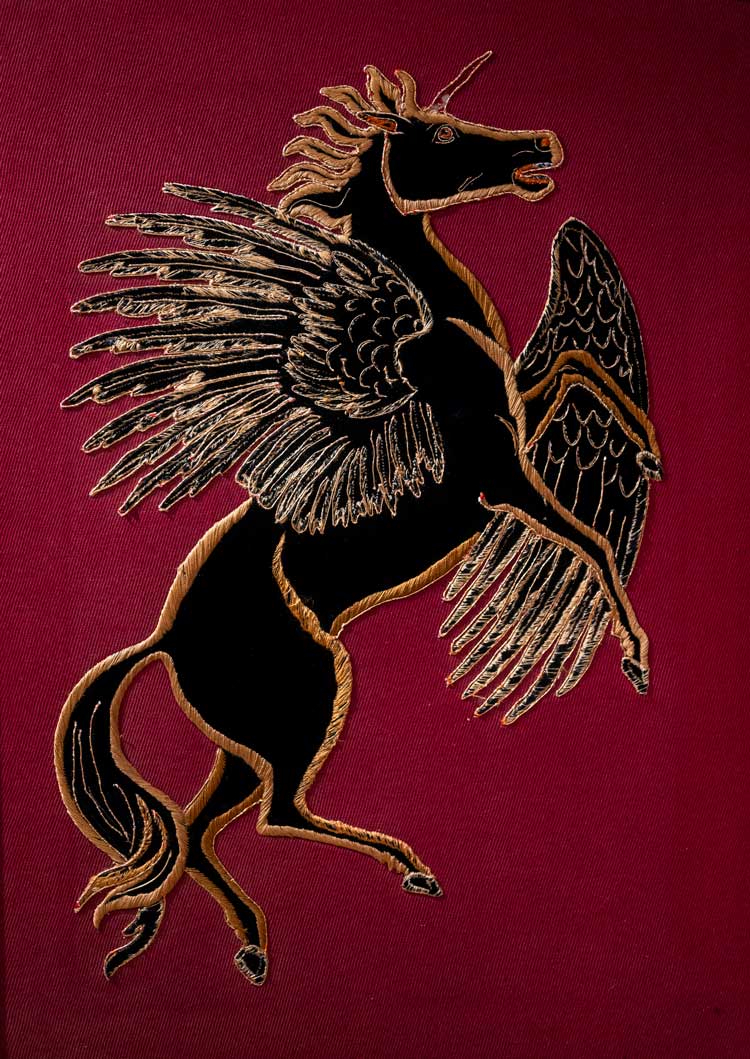
Draught screen sewn by Lady Mary Dalyell, 1910s (detail) from House of the Binns, West Lothian. Image courtesy of Dovecot Studios. Photo: Phil Wilkinson.
Aside from needlework skills and traditions being passed down through generations of families, women were absolutely central to maintaining embroidery skills in Scotland in other ways too. The 19th-century Kilbarchan Female School at Weaver’s Cottage, and the short-lived needlework school established philanthropically by Lady Aberdeen at Haddo House were important in this respect. The latter was intended for “the training and employment of girls in the district who do not desire to go out into the world, but who want to earn some money at or near home”. Ishbel, Lady Aberdeen brought textiles from Indian traders in Peshawar in 1887. These included “Bokhara quilts” from Kazakhstan, Uzbekistan, Tajikistan and other Central Asian countries, such as the one from Haddo House included in this exhibition. Other items of bedding on display include the blankets from Haddo House and Craigievar Castle made between 1890 and1910. Woollen blankets like these would have been needed in every household, although with inevitable differences in quality. The main centre for their production was Witney in Oxfordshire. Corner roses were embroidered by women and girls as a decorative finish for blankets heading to wealthier homes, such as Haddo and Craigievar.
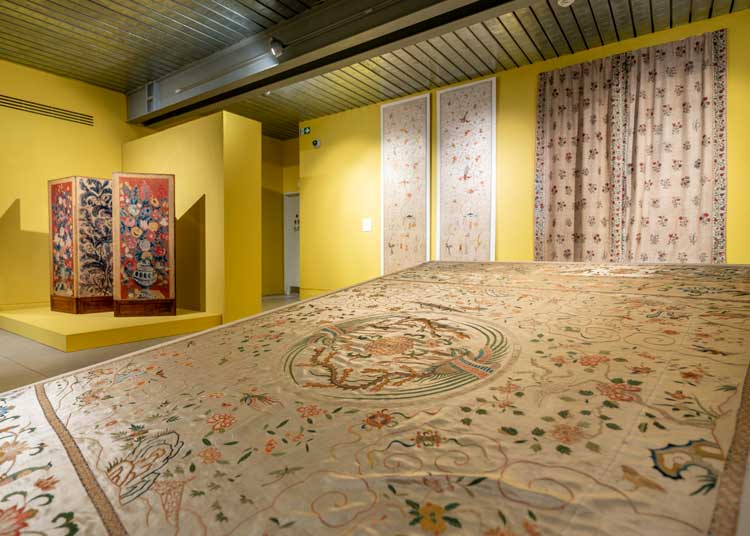
Stitched: Scotland’s Embroidered art at Dovecot Studios, Edinburgh. Image courtesy of Dovecot Studios. Photo: Phil Wilkinson.
Among the wall hangings from China, curtains from India and locally made embroideries of all kinds, is cloth sewn by Jeannie Black (later Skinner). It was made over two years from 1895, and Blake’s love of nature radiates from this piece featuring individually designed daffodils in pale yellow silk with an accompanying Shakespearian verse: “Daffodils, that come before the swallow dares, and take the winds of March with beauty”. Black was largely raised by her mother, a postmistress, and later married a mason, William Skinner. The couple settled in Balcormo as part of a group of local craftspeople commissioned by the Lorimer family to make work for Kellie Castle in the East Neuk of Fife. It is a splendid example of how the care and attention paid to subject and material can bring pleasure to the beholder and it is still a joy to encounter.
An exhibition such as this would not be complete without mention of the highly distinctive Glasgow Style. It was Newbery who instigated a radical art needlework course at Glasgow School of Art (GSA) in 1894. Newbery’s influence is clear in the work of Jane Younger, included in this exhibition, who studied at GSA intermittently from 1890. Younger’s use of the rose and leaf motif is typical of the school and the panel included in the exhibition was intended to be hung in her sister’s home at The Hill House in Helensburgh although it was later transformed into a bedcover. Notably, Younger’s work was shown at the First International Exhibition of Modern Decorative Art in Turin in 1902 and noted in The Studio that year.
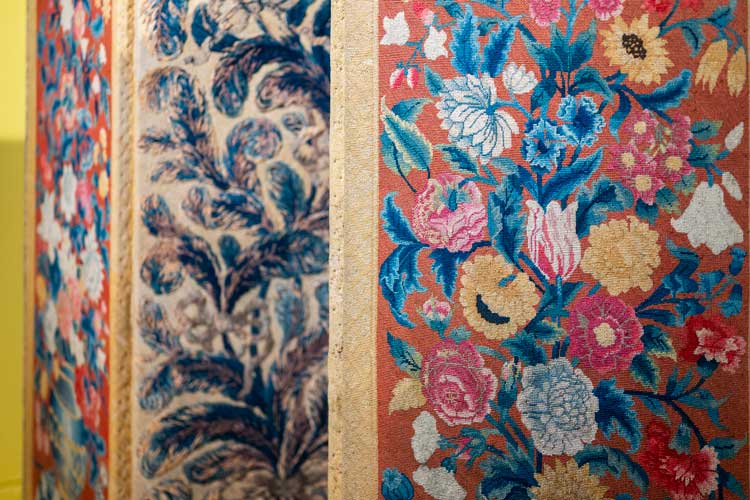
Draught screen attributed to Frances, Countess of Mar, 1720-40 (detail) from Alloa Tower, Clackmannanshire. Image courtesy of Dovecot Studios. Photo: Phil Wilkinson.
The objects that struck me most in this exhibition were the samplers, made by young girls and providing essential practice in the skills needed. These common childhood stitch samplers are utterly charming. Jessie and Mary Christie were the daughters of a handloom weaver and became apprentice weavers themselves at the age of 13. Their samplers were made in 1872 and 1873 respectively when they attended Kilbarchan Female School and demonstrate that there was room for individual creativity within the standard sampler format. Jane Dalrymple sewed her sampler between April and December in 1740. In each case, these were skills for life.
Following this exhibition, many of the objects on show will go on public display in their respective National Trust for Scotland historic properties for the first time, returning them anew to the domestic contexts for which they were intended. That is set to be very special indeed.